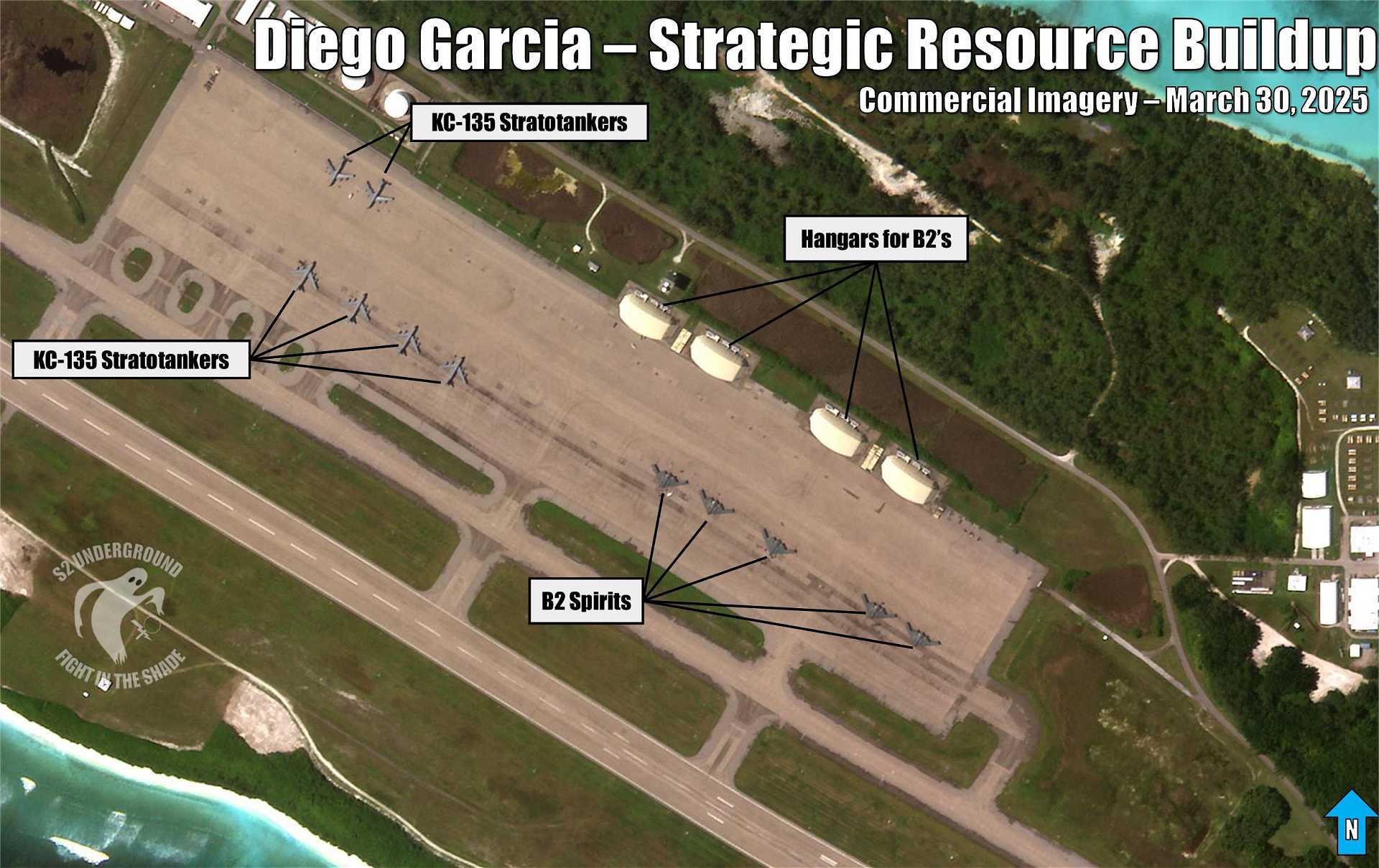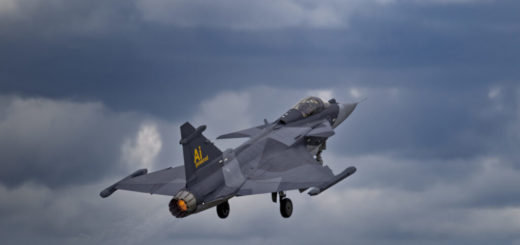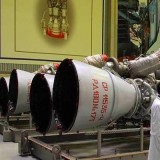Flash News: US Escalates Military Posture in Middle East as B-2 Bombers Deploy to Diego Garcia Military Base

{loadposition bannertop}
{loadposition sidebarpub}
According to information released by CNN World on April 2, 2025, the United States Air Force has deployed six B-2 Spirit stealth bombers, a C-17 military transport aircraft, and several KC-135 refueling tankers to Diego Garcia, a remote island base in the Indian Ocean that has historically served as a key launch point for U.S. operations in the Middle East and South Asia. The deployment comes as U.S. President Donald Trump and his defense chief, Pete Hegseth, warn of further action against Iran and its proxies, signaling a clear escalation in Washington’s military posture in response to growing tensions in the region. This latest deployment underscores a heightened state of readiness by the U.S. military and reflects a significant projection of American airpower.Follow Army Recognition on Google News at this link
U.S. Air Force B-2 Spirit stealth bombers alongside KC-135 refueling tanker aircraft parked on the tarmac at Diego Garcia, U.S. military air force base. The image, published by the S2 Underground X account on March 31, 2025, highlights the recent surge in U.S. strategic airpower deployment to the Indian Ocean base amid escalating tensions with Iran. (Picture source: S2 Underground X account)
The move follows an increasingly aggressive stance by U.S. President Trump, who has issued stark warnings to Iran over its nuclear ambitions and support for proxy groups such as the Houthi rebels in Yemen. In a highly publicized statement on March 30, 2025, Trump declared, “If they don’t do a deal, there will be bombing,” signaling the administration’s willingness to employ military force if diplomatic negotiations with Tehran fail. Trump and Defense Secretary Hegseth have repeatedly accused Iran of violating international norms and destabilizing the region through its proxy network. U.S. officials argue that recent Houthi attacks—allegedly backed by Iran—justify direct strikes against Iranian-linked assets. Trump has vowed that the U.S. will not hesitate to act preemptively to prevent Iran from acquiring nuclear weapons capabilities.
Diego Garcia is a small, isolated atoll located in the central Indian Ocean. Though it is officially part of the British Indian Ocean Territory, the island has long been used as a major U.S. military base under a lease agreement with the United Kingdom. Its remote yet strategic location—roughly 4,828km (3,000 miles) from the Persian Gulf—makes it a vital hub for projecting American military power across the Middle East, East Africa, and South Asia. The island is equipped with a long runway capable of hosting heavy bomber aircraft like the B-2 Spirit, strategic transport aircraft such as the C-17, and aerial refueling tankers like the KC-135. It also features port facilities, extensive fuel storage, and intelligence infrastructure. Historically, Diego Garcia has played a key role in major U.S. military operations, including the Gulf War and campaigns in Afghanistan and Iraq. Despite its strategic value, the island’s political status remains controversial due to the displacement of its original inhabitants, the Chagossians, in the 20th century—a subject of ongoing international legal disputes.
The deployment of the B-2 Spirit bomber underscores the seriousness of the U.S. posture. The B-2, with its advanced stealth technology, is capable of penetrating heavily defended airspace and striking strategic targets with high precision. It can carry both conventional and nuclear weapons, including the GBU-57 Massive Ordnance Penetrator, a bunker-busting bomb specifically designed to destroy deeply buried facilities—ideal for neutralizing underground Iranian nuclear sites or fortified Houthi infrastructure. The B-2 has an unrefueled range of approximately 6,000 nautical miles, but when supported by aerial refueling, it can remain airborne and operational over distant theaters for extended periods.
To support sustained operations from Diego Garcia, the U.S. has also deployed KC-135 Stratotankers, which are critical for in-flight refueling of the B-2 Spirit and other aircraft. This capability greatly extends the operational reach and flexibility of U.S. bombers, enabling them to strike distant targets in Iran or Yemen without needing to land. The KC-135’s presence ensures that the U.S. can conduct continuous, long-duration sorties while maintaining a high tempo of operations from a geographically remote base.
The military buildup has not gone unnoticed by Tehran. In response to Trump’s ultimatum, Iranian Supreme Leader Ayatollah Ali Khamenei warned that Iran would deliver a “strong blow” if attacked. Iranian military leaders have even hinted at potential preemptive strikes against U.S. assets in the region, including Diego Garcia, which they perceive as a major threat. The risk of escalation remains high as both nations continue to trade threats and prepare for potential confrontation.
The broader Middle East region is experiencing heightened instability, with multiple flashpoints contributing to the current crisis. In Yemen, the Iran-backed Houthi rebels have intensified their attacks on shipping lanes in the Red Sea, targeting commercial vessels and U.S. warships. These actions have disrupted global trade and prompted a series of U.S. airstrikes against Houthi positions. The U.S. has accused Iran of supplying advanced weaponry to the Houthis, including missiles and drones used in these attacks. The ongoing conflict in Yemen has exacerbated the humanitarian crisis, with rights groups expressing concern over civilian casualties resulting from the intensified bombing campaigns.
In addition to the deployment of B-21 Spirit bomber aircraft to Diego Garcia, the U.S. has bolstered its naval presence in the region. The USS Harry S. Truman carrier strike group has had its deployment extended, and the USS Carl Vinson has been dispatched to reinforce U.S. capabilities in the Middle East. This augmentation of naval power aims to deter Iranian aggression and ensure the security of vital maritime routes.
The international community remains deeply concerned about the potential for a broader conflict. Oil markets have reacted cautiously to the escalating tensions, with analysts warning of significant economic repercussions should the situation deteriorate further. Diplomatic efforts continue, but the window for a peaceful resolution appears to be narrowing as both sides adopt increasingly confrontational stances.
The deployment by the United States of B-2 Spirit strategic bomber aircraft and KC-135 refueling aircraft to Diego Garcia, coupled with an enhanced naval presence, signals a clear U.S. intent to maintain military pressure on Iran. As diplomatic efforts stall and rhetoric intensifies, this forward positioning provides Washington with the operational capability to act swiftly, should the order be given. The situation remains fluid, with the potential for rapid escalation if diplomatic solutions are not found.

{loadposition bannertop}
{loadposition sidebarpub}
According to information released by CNN World on April 2, 2025, the United States Air Force has deployed six B-2 Spirit stealth bombers, a C-17 military transport aircraft, and several KC-135 refueling tankers to Diego Garcia, a remote island base in the Indian Ocean that has historically served as a key launch point for U.S. operations in the Middle East and South Asia. The deployment comes as U.S. President Donald Trump and his defense chief, Pete Hegseth, warn of further action against Iran and its proxies, signaling a clear escalation in Washington’s military posture in response to growing tensions in the region. This latest deployment underscores a heightened state of readiness by the U.S. military and reflects a significant projection of American airpower.
Follow Army Recognition on Google News at this link
U.S. Air Force B-2 Spirit stealth bombers alongside KC-135 refueling tanker aircraft parked on the tarmac at Diego Garcia, U.S. military air force base. The image, published by the S2 Underground X account on March 31, 2025, highlights the recent surge in U.S. strategic airpower deployment to the Indian Ocean base amid escalating tensions with Iran. (Picture source: S2 Underground X account)
The move follows an increasingly aggressive stance by U.S. President Trump, who has issued stark warnings to Iran over its nuclear ambitions and support for proxy groups such as the Houthi rebels in Yemen. In a highly publicized statement on March 30, 2025, Trump declared, “If they don’t do a deal, there will be bombing,” signaling the administration’s willingness to employ military force if diplomatic negotiations with Tehran fail. Trump and Defense Secretary Hegseth have repeatedly accused Iran of violating international norms and destabilizing the region through its proxy network. U.S. officials argue that recent Houthi attacks—allegedly backed by Iran—justify direct strikes against Iranian-linked assets. Trump has vowed that the U.S. will not hesitate to act preemptively to prevent Iran from acquiring nuclear weapons capabilities.
Diego Garcia is a small, isolated atoll located in the central Indian Ocean. Though it is officially part of the British Indian Ocean Territory, the island has long been used as a major U.S. military base under a lease agreement with the United Kingdom. Its remote yet strategic location—roughly 4,828km (3,000 miles) from the Persian Gulf—makes it a vital hub for projecting American military power across the Middle East, East Africa, and South Asia. The island is equipped with a long runway capable of hosting heavy bomber aircraft like the B-2 Spirit, strategic transport aircraft such as the C-17, and aerial refueling tankers like the KC-135. It also features port facilities, extensive fuel storage, and intelligence infrastructure. Historically, Diego Garcia has played a key role in major U.S. military operations, including the Gulf War and campaigns in Afghanistan and Iraq. Despite its strategic value, the island’s political status remains controversial due to the displacement of its original inhabitants, the Chagossians, in the 20th century—a subject of ongoing international legal disputes.
The deployment of the B-2 Spirit bomber underscores the seriousness of the U.S. posture. The B-2, with its advanced stealth technology, is capable of penetrating heavily defended airspace and striking strategic targets with high precision. It can carry both conventional and nuclear weapons, including the GBU-57 Massive Ordnance Penetrator, a bunker-busting bomb specifically designed to destroy deeply buried facilities—ideal for neutralizing underground Iranian nuclear sites or fortified Houthi infrastructure. The B-2 has an unrefueled range of approximately 6,000 nautical miles, but when supported by aerial refueling, it can remain airborne and operational over distant theaters for extended periods.
To support sustained operations from Diego Garcia, the U.S. has also deployed KC-135 Stratotankers, which are critical for in-flight refueling of the B-2 Spirit and other aircraft. This capability greatly extends the operational reach and flexibility of U.S. bombers, enabling them to strike distant targets in Iran or Yemen without needing to land. The KC-135’s presence ensures that the U.S. can conduct continuous, long-duration sorties while maintaining a high tempo of operations from a geographically remote base.
The military buildup has not gone unnoticed by Tehran. In response to Trump’s ultimatum, Iranian Supreme Leader Ayatollah Ali Khamenei warned that Iran would deliver a “strong blow” if attacked. Iranian military leaders have even hinted at potential preemptive strikes against U.S. assets in the region, including Diego Garcia, which they perceive as a major threat. The risk of escalation remains high as both nations continue to trade threats and prepare for potential confrontation.
The broader Middle East region is experiencing heightened instability, with multiple flashpoints contributing to the current crisis. In Yemen, the Iran-backed Houthi rebels have intensified their attacks on shipping lanes in the Red Sea, targeting commercial vessels and U.S. warships. These actions have disrupted global trade and prompted a series of U.S. airstrikes against Houthi positions. The U.S. has accused Iran of supplying advanced weaponry to the Houthis, including missiles and drones used in these attacks. The ongoing conflict in Yemen has exacerbated the humanitarian crisis, with rights groups expressing concern over civilian casualties resulting from the intensified bombing campaigns.
In addition to the deployment of B-21 Spirit bomber aircraft to Diego Garcia, the U.S. has bolstered its naval presence in the region. The USS Harry S. Truman carrier strike group has had its deployment extended, and the USS Carl Vinson has been dispatched to reinforce U.S. capabilities in the Middle East. This augmentation of naval power aims to deter Iranian aggression and ensure the security of vital maritime routes.
The international community remains deeply concerned about the potential for a broader conflict. Oil markets have reacted cautiously to the escalating tensions, with analysts warning of significant economic repercussions should the situation deteriorate further. Diplomatic efforts continue, but the window for a peaceful resolution appears to be narrowing as both sides adopt increasingly confrontational stances.
The deployment by the United States of B-2 Spirit strategic bomber aircraft and KC-135 refueling aircraft to Diego Garcia, coupled with an enhanced naval presence, signals a clear U.S. intent to maintain military pressure on Iran. As diplomatic efforts stall and rhetoric intensifies, this forward positioning provides Washington with the operational capability to act swiftly, should the order be given. The situation remains fluid, with the potential for rapid escalation if diplomatic solutions are not found.





